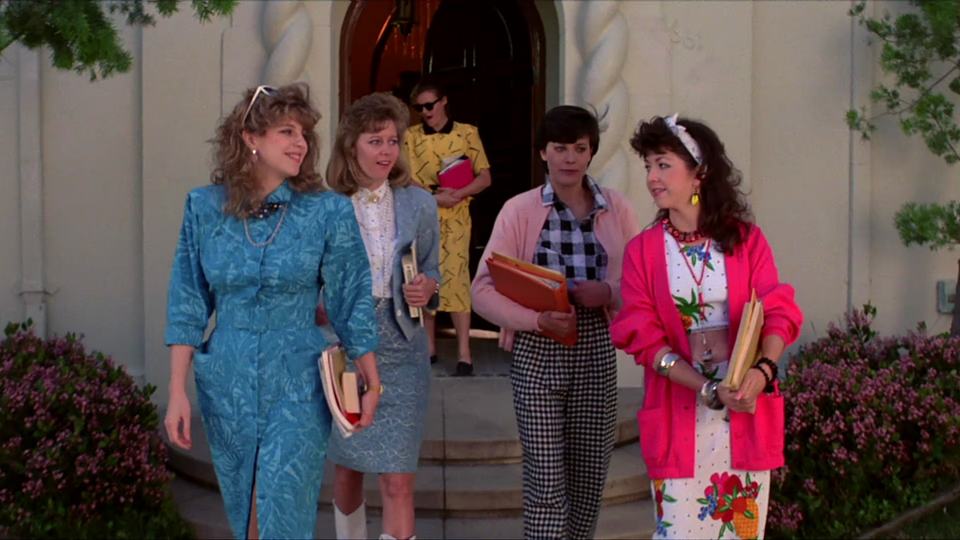Sorority House Massacre

Writer-director Carol Frank brings an entertaining dose of deadpan humor and art-house style to bear in this story of an escaped mental patient terrorizing a house full of teens over Memorial Day weekend.
The film centers on college student Beth, who is still grieving the death of the aunt who raised her, as she moves into a sorority house. Nightmares plague her sleep.
An early example follows Beth exploring the house, except the furnishings are different, reflecting a single family. She creeps into the dining room to discover the table set, candles lit, but lifeless dolls occupying the seats. From the ceiling, blood drips down the chandelier, splashing the white tablecloth. She goes upstairs into a child’s bedroom, where she sees a small body under the bed’s covers. She pulls them back to reveal a puddle of blood.
These sequences brandish a restrained, surrealistic flair unusual in the gritty slasher genre. Indeed, those genre fans who prize elaborate gruesome kill scenes will be disappointed. This film’s murders occur as swift, aggressive stabbings akin to a sudden punch in the gut. While not gory, they convey an effective sense of mindless rage.
The story cuts between Beth and her sorority sisters, and a state mental hospital holding a man named Bobby, incarcerated for killing his family. We realize Bobby and Beth are sharing dreams—him seeing out of her eyes and vice versa. This psychic link enrages Bobby, leading him to escape the hospital in search of Beth, setting up the murderous finale.
The plot will feel familiar—even derivative—to fans of the Halloween franchise. Yes, the notion of a man killing his family, then escaping to finish off his sister, mirrors the story of Halloween and Halloween II, but credit the film with its telepathic link between Beth and Bobby, a device the Halloween franchise would co-opt in part five.
Frank served as director Amy Holden Jones’ personal assistant on 1982’s The Slumber Party Massacre, and this film shares its female-centric sensibility. As in The Slumber Party Massacre, the killer lacks a mask or gimmick. He’s just a nondescript, angry man. And once again, the male teens prove ineffectual against the killer. When Bobby attacks a teen couple having sex in a teepee, it’s the guy who flees naked.
Frank also injects a welcome streak of black humor. In a montage spanning the girls’ day in class, we see one bemoan a “pop psychology quiz,” and later when watching a film in class, as the narrator drones, “Death, it comes to all of us yet how often do we consider our own mortality? Too frequently we’re caught up in daily matters of the self to face this aspect,” we see her reading an issue of Self magazine.
At one point, the girls watch The Slumber Party Massacre on television, but a better bit if meta-humor comes when they try to interpret Beth’s dreams, claiming Beth’s vision of a jar of marbles crashing means she’s losing her marbles. This one line obliterates any art-house pretensions and clues the viewer into the film’s sense of humor.
Thus, one can better appreciate the third act’s inanity as a satire of slasher tropes. Consider the sequence where the survivors have barricaded themselves inside a second-floor bedroom. A failed escape attempt via a fire ladder sees the killer ascending. They dislodge the ladder and send him falling two stories to the ground. As the teens unbar the bedroom door, the killer dives through the window. They run downstairs and outside, only to find themselves cut off by the killer.
Hearkening back to Jason’s inexplicable movements in Friday the 13th: The Final Chapter, the killer has executed a dive into a second-floor window, then teleported to the front of the house.
The surviving kids head back indoors. Did I mention, to exit, the kids needed a key to unlock the front door? Now they can’t lock the house because they lack said key. So, instead of running out the back, they, of course, run into the basement. Because of the film’s established sense of humor, we appreciate this as satire, instead of bemoaning it as idiot plotting.
As I write this, The Slumber Party Massacre is enjoying a critical reassessment. But I’d posit this entry as superior. Frank had the advantage of going second, learning from Holden Jones, and improving on her film’s faults. Serving as both writer and director allowed Frank to deliver the exploitative thrills producer Roger Corman wanted while maintaining a consistent tone, something The Slumber Party Massacre struggled to achieve. As a low-key slasher satire, it entertains. As a stripped-down Halloween remake, it outshines Rob Zombie’s version. Gorehounds may find themselves disappointed, but genre fans should appreciate the deep-cut humor.